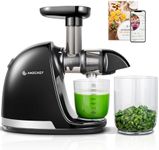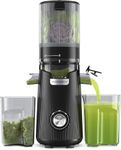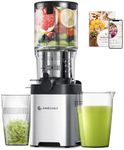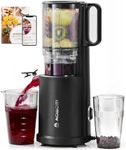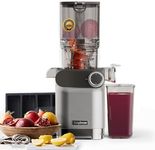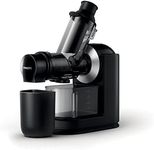Buying Guide for the Best Masticating Juicers
Masticating juicers, also known as slow juicers or cold press juicers, are a popular choice for those who want to extract juice from fruits and vegetables while preserving nutrients and enzymes. These juicers operate at a slower speed compared to centrifugal juicers, which helps in minimizing heat build-up and oxidation, resulting in juice that can be stored for longer periods. When choosing a masticating juicer, it's important to consider several key specifications to ensure you select a model that best fits your juicing needs and lifestyle.Juicing SpeedJuicing speed in masticating juicers refers to the revolutions per minute (RPM) at which the juicer operates. This is important because lower speeds typically mean less heat and oxidation, preserving more nutrients in the juice. Masticating juicers usually operate between 40 to 100 RPM. If you prioritize nutrient retention and plan to juice leafy greens or wheatgrass, opt for a juicer with a lower RPM. For those who are less concerned about nutrient retention and more about speed, a higher RPM might be acceptable.
Feed Chute SizeThe feed chute size determines how much preparation is needed before juicing. A larger feed chute allows you to insert bigger pieces of fruits and vegetables, reducing prep time. Chutes can range from small, requiring more chopping, to wide, which can accommodate whole fruits like apples. If you prefer convenience and want to save time, look for a juicer with a larger feed chute. However, if you don't mind spending a bit more time on preparation, a smaller chute might suffice.
Juice YieldJuice yield refers to the amount of juice extracted from a given amount of produce. This is crucial for efficiency and cost-effectiveness, especially if you juice frequently. Masticating juicers are known for their high juice yield compared to other types. When evaluating juice yield, consider how much juice you want to extract from your produce. If maximizing juice output is important to you, look for models that are specifically noted for high yield, especially with leafy greens.
Ease of CleaningEase of cleaning is an important factor because it affects how often you will use your juicer. Masticating juicers can have multiple parts that need cleaning after each use. Some models are designed with fewer parts or dishwasher-safe components to simplify the cleaning process. If you value convenience and want to ensure regular use of your juicer, choose a model that is easy to disassemble and clean. If you don't mind spending extra time on maintenance, this may be less of a concern.
Noise LevelNoise level is the amount of sound the juicer produces while operating. Masticating juicers are generally quieter than centrifugal juicers, but there can still be variations. Noise level is important if you plan to juice early in the morning or late at night when others might be sleeping. If a quiet operation is a priority for you, look for models that are specifically noted for their low noise levels. If noise is not a concern, this specification might be less critical.
Durability and Build QualityDurability and build quality refer to how well the juicer is constructed and how long it is likely to last. This is important for ensuring that your investment will withstand regular use over time. Masticating juicers can be made from a variety of materials, including plastic and stainless steel. If you plan to use your juicer frequently, look for models with high-quality materials and good reviews on durability. If you only plan to use it occasionally, this might be less of a priority.

